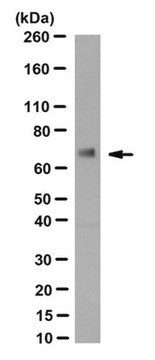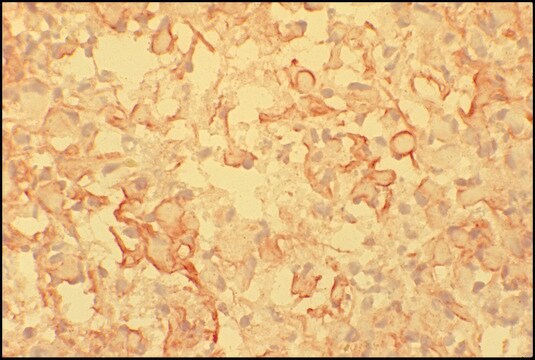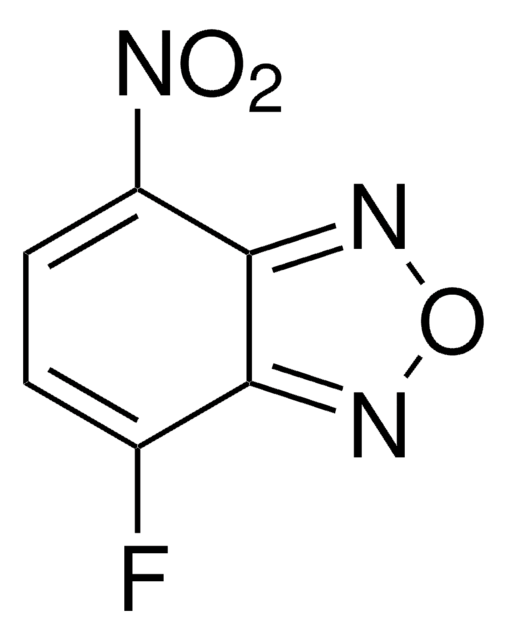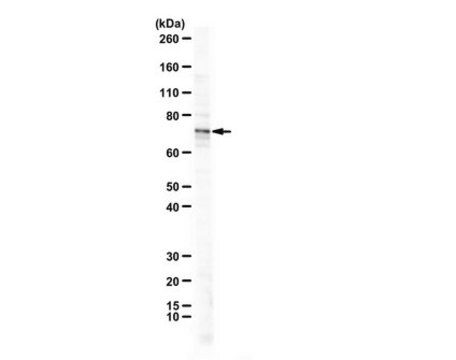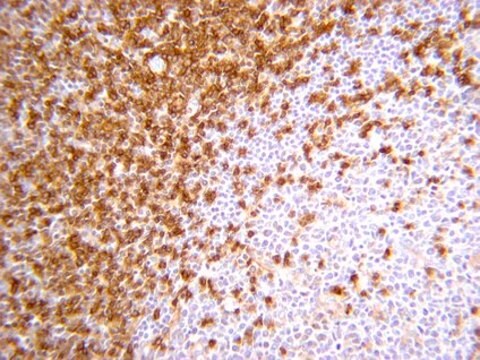MABF3038
Anti-Rhinovirus Capsid VP1 Antibody, clone HRV-18003
Synonim(y):
HRV-kapsyd VP1
About This Item
Polecane produkty
pochodzenie biologiczne
mouse
Poziom jakości
forma przeciwciała
purified antibody
rodzaj przeciwciała
primary antibodies
klon
HRV-18003, monoclonal
masa cząsteczkowa
calculated mol wt 242.824 kDa
observed mol wt ~32 kDa
oczyszczone przez
using protein G
reaktywność gatunkowa
virus
opakowanie
antibody small pack of 100
metody
ELISA: suitable
inhibition assay: suitable
western blot: suitable
izotyp
IgG2aκ
sekwencja epitopowa
N-terminal half
numer dostępu Protein ID
numer dostępu UniProt
temp. przechowywania
-10 to -25°C
Specyficzność
Immunogen
Zastosowanie
Oceniane metodą Western Blotting z rekombinowanym białkiem kapsydu VP1 wirusa Rhinovirus.
Analiza Western Blotting: Rozcieńczenie 1:125 tego przeciwciała wykryło rekombinowane białko kapsydu VP1 rinowirusa.
Testowane aplikacje
Test funkcjonalny Reprezentatywna partia tego przeciwciała wykazywała silną aktywność w teście fagocytozy komórkowej zależnej od przeciwciał (ADCP) in vitro. (Behzadi, M.A., et al. (2020). Sci Rep.;10(1):9750).
Analiza Western Blotting: Reprezentatywna partia wykryła HRV-18003 rozpoznaje VP1 w aplikacjach Western Blotting (Behzadi, M.A., et al. (2020). Sci Rep.;10(1):9750).
Analiza ELISA: Reprezentatywna partia wykryła HRV-18003 rozpoznaje VP1 w zastosowaniach ELISA (Behzadi, M.A., et al. (2020). Sci Rep.;10(1):9750).
Uwaga: Rzeczywiste optymalne rozcieńczenia robocze muszą być określone przez użytkownika końcowego jako próbki, a warunki eksperymentalne mogą się różnić w zależności od użytkownika końcowego.
Opis wartości docelowych
Postać fizyczna
Rekonstytucja
Przechowywanie i stabilność
Inne uwagi
Oświadczenie o zrzeczeniu się odpowiedzialności
Nie możesz znaleźć właściwego produktu?
Wypróbuj nasz Narzędzie selektora produktów.
Kod klasy składowania
12 - Non Combustible Liquids
Klasa zagrożenia wodnego (WGK)
WGK 2
Temperatura zapłonu (°F)
Not applicable
Temperatura zapłonu (°C)
Not applicable
Certyfikaty analizy (CoA)
Poszukaj Certyfikaty analizy (CoA), wpisując numer partii/serii produktów. Numery serii i partii można znaleźć na etykiecie produktu po słowach „seria” lub „partia”.
Masz już ten produkt?
Dokumenty związane z niedawno zakupionymi produktami zostały zamieszczone w Bibliotece dokumentów.
Nasz zespół naukowców ma doświadczenie we wszystkich obszarach badań, w tym w naukach przyrodniczych, materiałoznawstwie, syntezie chemicznej, chromatografii, analityce i wielu innych dziedzinach.
Skontaktuj się z zespołem ds. pomocy technicznej
